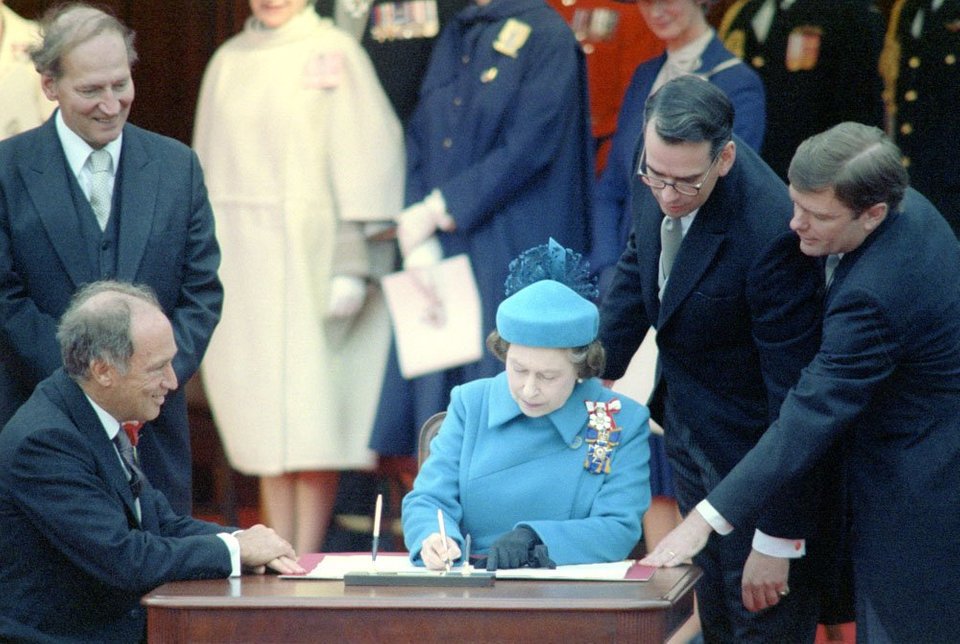
Two weeks ago here at History Things, we explored the birth of the United States Constitution and the process by which America became a sovereign nation. All across America daily, High School students roll their eyes and dread the thought of digging into their Constitutional Law and Civics textbooks, but after exploring Canada’s Constitutional History every American child should keep their Canadian counterparts in their thoughts.
The difference between the two is striking and is akin to apples and oranges. The United States Constitution was a necessity and an emergency hammered out in the summer to implement the law of the land, Canada’s has taken over three hundred years of changes and continues to face new challenges. Yes, the American Constitution has been changed twenty-seven times since the 1780s, that pales in comparison to the changes that have met the Canadian people.
Unlike America, the Candian people did not revolt against the British crown, that is the crux of the complicated history of the supreme law of the land. Over time, the British and the Canadians worked together amicably, and sometimes with high tension, to define the relationship between the two countries.
Canada came under British control after the British and the American Colonists defeated the French and their Native American Confederation allies in the French and Indian War (called the Seven Years War in Europe). After France was forced to cede that Canadian territory to the British, the crown began implementing their appointed governors to the new colonies. Canada was split into Upper and Lower Canada, with the present day province of Quebec being the latter and Ontario the former.
The two colonies didn’t necessarily like being lumped together, the predominantly French-Canadian citizenry of Lower Canada held resentment towards the British for obvious reasons. To attempt and bring the two sides together, the British Parliament issued the Quebec Act of 1774 that attempted to mend those proverbial fences, French speakers were no longer shunned from serving in public office, and other minor changes were made as well.
The British knew that they could not afford Canada to fall apart at the seams because, at that same time, the American Colonies were pushing further towards the Revolution. With the two Canadas mollified, the British could focus their attention on the thirteen American Colonies.
After the Americans won their Independence, the Loyalists from the country (Americans who sided with the crown), flooded into Canada by the hundreds, even thousands, and changed the makeup of the citizenry. The Crown realized that with that influx of Americans and the loss of their valuable colonies, they simply had to keep the peace in Canada and turn its attention to making Canada pick up the slack so to speak.
The Constitutional Act of 1791 gave Canada its first Parliamentary Constitution, introducing fifty articles, but it failed to bring the colony together. The Act made the separation between Upper and Lower Canada more pronounced. What is most interesting is it implemented two entirely different forms of law and government, Lower Canada was allowed to keep French Law, while Upper Canada held British law as their supreme rule.
The difficulties of having two English Colonies so close together, practice entirely different forms of law and government wasn’t lost of the Crown, something needed to change. The Act of 1791 lasted forty-nine years before the Act of Union in 1840. The Act of Union unified Quebec with the rest of Canada, ending the French law and government system in the province. This did not force Quebec to quit speaking French or change their culture, but it did force the province to adhere to British law.
The most important aspect of the Act of Union was the creation of Canada’s first Parliament. Having little overall power at the start, it was a starting place for self-rule that would evolve further over the years.
The watershed event was the British North America Act of 1867, unifying all of Canada, setting up westward expansion and creating a two-house legislative body. The 1840 Parliament was tweaked to now contain a population-based House of Commons and a Senate with 24 members from each Province. The British Parliament still had some power over Canada, but that was soon eliminated in 1931 when British Parliament was told to stay out unless asked, and finally in 1982 when Canada’s Parliament gained total autonomy. The only vestige of British rule is the fact that Canada recognizes the British Monarch as the King or Queen of Canada as a figurehead.

The Queen signs the Constitution Act of 1982, giving Canada the final piece of the puzzle for Independence.
Without a doubt, the most interesting fact about the modern Canadian Constitution is the ideas of Laws and Customs. Canada literally has unwritten rules of their Constitution, think about that for a second, the supreme law of the land has rules that the people just agree should be there but aren’t. The most important of these customs is the fact that the Legislative Bodies of Canada can oust the Prime Minister, the PM must have the support or “confidence” of the legislative bodies of the Nation.
Such a deep and exciting evolution of law from Canada, coming from an American perspective it is astounding how difficult it has been over the years for Canada to slowly gain its own identity. It’s not a knock; on the contrary, it’s impressive and admirable how the country has evolved and changed itself since its original colonial rule.

